Report on Ergonomics & Warehouse Staffs: Health and Wellbeing
VerifiedAdded on 2020/04/21
|15
|3577
|156
Report
AI Summary
This report addresses the critical issue of ergonomics and its impact on warehouse staff, particularly focusing on the challenges posed by long working hours and shift work. It examines the health risks associated with these conditions, including sleep disorders, mental health issues, and increased susceptibility to various diseases. The report highlights the extent of the problem, emphasizing the need for proactive measures to mitigate these risks and improve worker wellbeing. It provides expert advice and suggests practical solutions, such as implementing cognitive testing to assess employee fatigue and sleep patterns. Furthermore, the report advocates for a three-stage prevention strategy, encompassing primary, secondary, and tertiary prevention methods to minimize the adverse effects of occupational health hazards. Ultimately, the report aims to inform the board of directors, emphasizing the importance of prioritizing employee health to ensure sustained productivity and business growth.
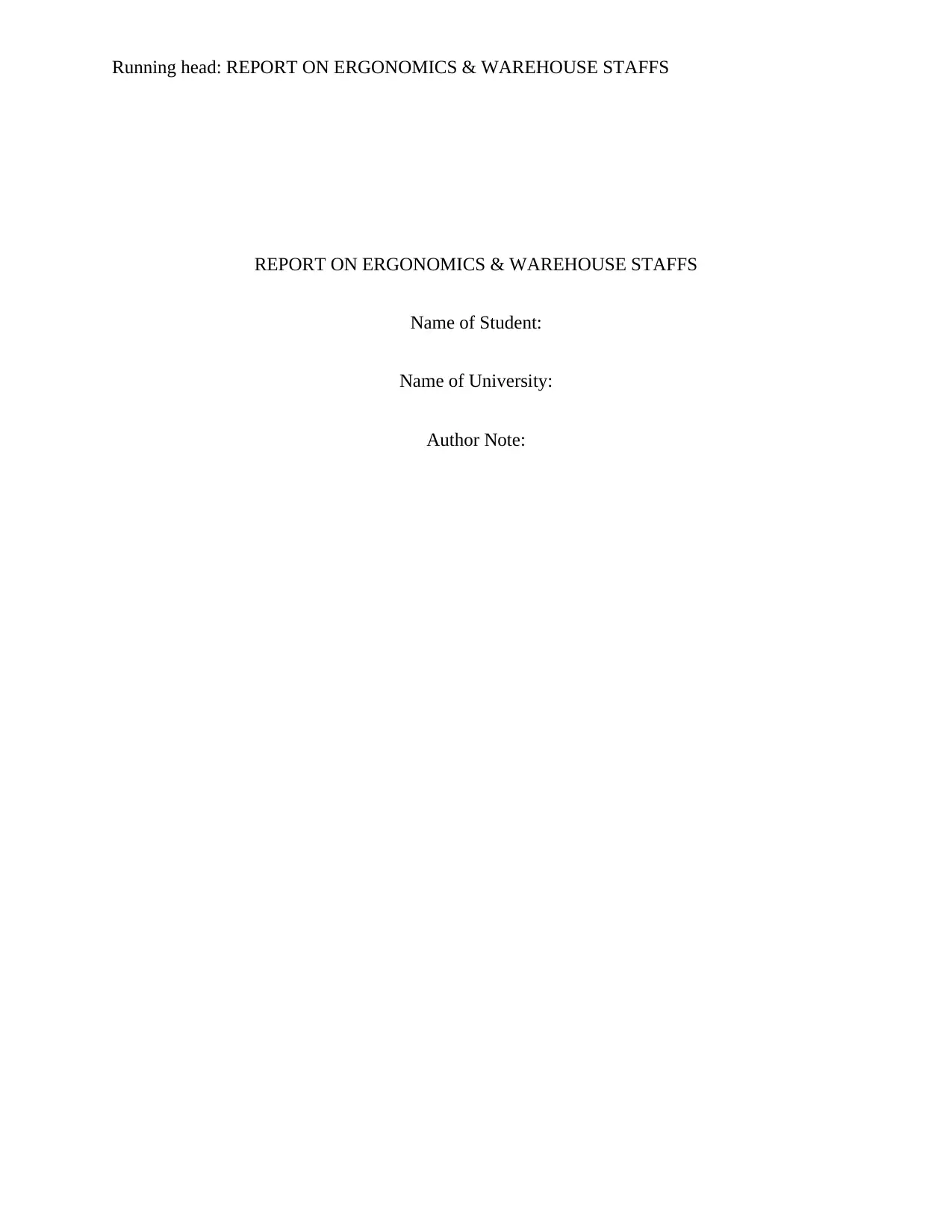
Running head: REPORT ON ERGONOMICS & WAREHOUSE STAFFS
REPORT ON ERGONOMICS & WAREHOUSE STAFFS
Name of Student:
Name of University:
Author Note:
REPORT ON ERGONOMICS & WAREHOUSE STAFFS
Name of Student:
Name of University:
Author Note:
Paraphrase This Document
Need a fresh take? Get an instant paraphrase of this document with our AI Paraphraser
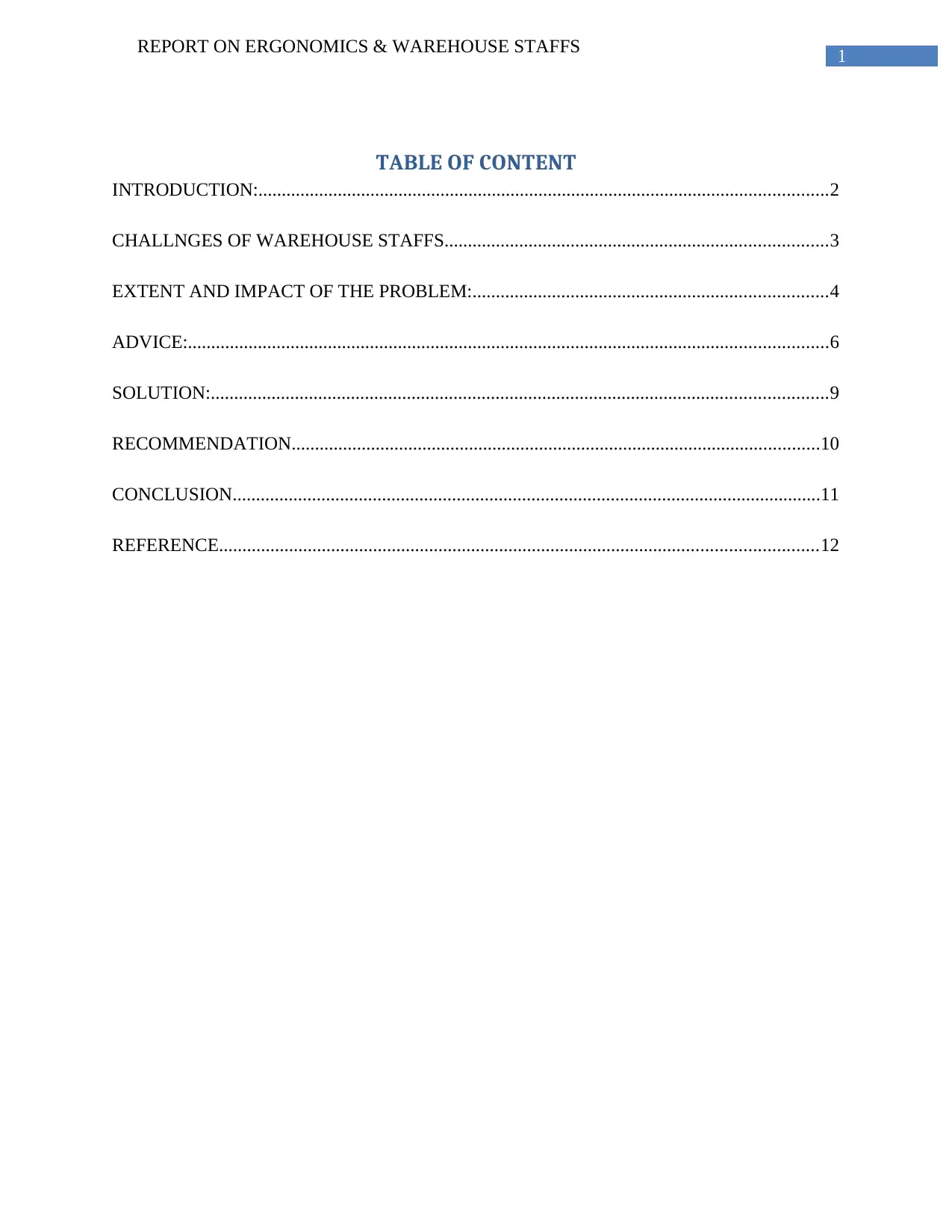
1
REPORT ON ERGONOMICS & WAREHOUSE STAFFS
TABLE OF CONTENT
INTRODUCTION:..........................................................................................................................2
CHALLNGES OF WAREHOUSE STAFFS..................................................................................3
EXTENT AND IMPACT OF THE PROBLEM:............................................................................4
ADVICE:.........................................................................................................................................6
SOLUTION:....................................................................................................................................9
RECOMMENDATION.................................................................................................................10
CONCLUSION..............................................................................................................................11
REFERENCE................................................................................................................................12
REPORT ON ERGONOMICS & WAREHOUSE STAFFS
TABLE OF CONTENT
INTRODUCTION:..........................................................................................................................2
CHALLNGES OF WAREHOUSE STAFFS..................................................................................3
EXTENT AND IMPACT OF THE PROBLEM:............................................................................4
ADVICE:.........................................................................................................................................6
SOLUTION:....................................................................................................................................9
RECOMMENDATION.................................................................................................................10
CONCLUSION..............................................................................................................................11
REFERENCE................................................................................................................................12
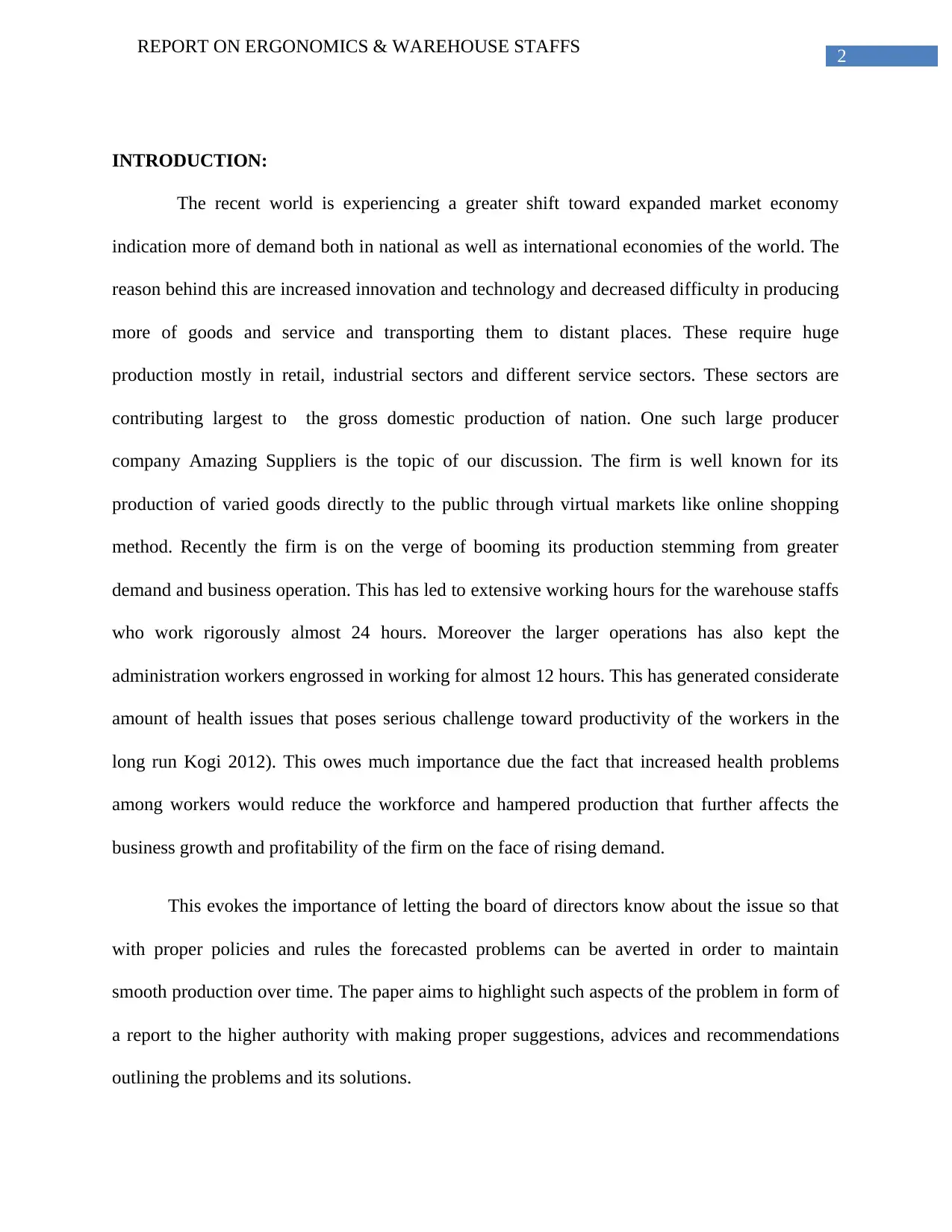
2
REPORT ON ERGONOMICS & WAREHOUSE STAFFS
INTRODUCTION:
The recent world is experiencing a greater shift toward expanded market economy
indication more of demand both in national as well as international economies of the world. The
reason behind this are increased innovation and technology and decreased difficulty in producing
more of goods and service and transporting them to distant places. These require huge
production mostly in retail, industrial sectors and different service sectors. These sectors are
contributing largest to the gross domestic production of nation. One such large producer
company Amazing Suppliers is the topic of our discussion. The firm is well known for its
production of varied goods directly to the public through virtual markets like online shopping
method. Recently the firm is on the verge of booming its production stemming from greater
demand and business operation. This has led to extensive working hours for the warehouse staffs
who work rigorously almost 24 hours. Moreover the larger operations has also kept the
administration workers engrossed in working for almost 12 hours. This has generated considerate
amount of health issues that poses serious challenge toward productivity of the workers in the
long run Kogi 2012). This owes much importance due the fact that increased health problems
among workers would reduce the workforce and hampered production that further affects the
business growth and profitability of the firm on the face of rising demand.
This evokes the importance of letting the board of directors know about the issue so that
with proper policies and rules the forecasted problems can be averted in order to maintain
smooth production over time. The paper aims to highlight such aspects of the problem in form of
a report to the higher authority with making proper suggestions, advices and recommendations
outlining the problems and its solutions.
REPORT ON ERGONOMICS & WAREHOUSE STAFFS
INTRODUCTION:
The recent world is experiencing a greater shift toward expanded market economy
indication more of demand both in national as well as international economies of the world. The
reason behind this are increased innovation and technology and decreased difficulty in producing
more of goods and service and transporting them to distant places. These require huge
production mostly in retail, industrial sectors and different service sectors. These sectors are
contributing largest to the gross domestic production of nation. One such large producer
company Amazing Suppliers is the topic of our discussion. The firm is well known for its
production of varied goods directly to the public through virtual markets like online shopping
method. Recently the firm is on the verge of booming its production stemming from greater
demand and business operation. This has led to extensive working hours for the warehouse staffs
who work rigorously almost 24 hours. Moreover the larger operations has also kept the
administration workers engrossed in working for almost 12 hours. This has generated considerate
amount of health issues that poses serious challenge toward productivity of the workers in the
long run Kogi 2012). This owes much importance due the fact that increased health problems
among workers would reduce the workforce and hampered production that further affects the
business growth and profitability of the firm on the face of rising demand.
This evokes the importance of letting the board of directors know about the issue so that
with proper policies and rules the forecasted problems can be averted in order to maintain
smooth production over time. The paper aims to highlight such aspects of the problem in form of
a report to the higher authority with making proper suggestions, advices and recommendations
outlining the problems and its solutions.
⊘ This is a preview!⊘
Do you want full access?
Subscribe today to unlock all pages.

Trusted by 1+ million students worldwide
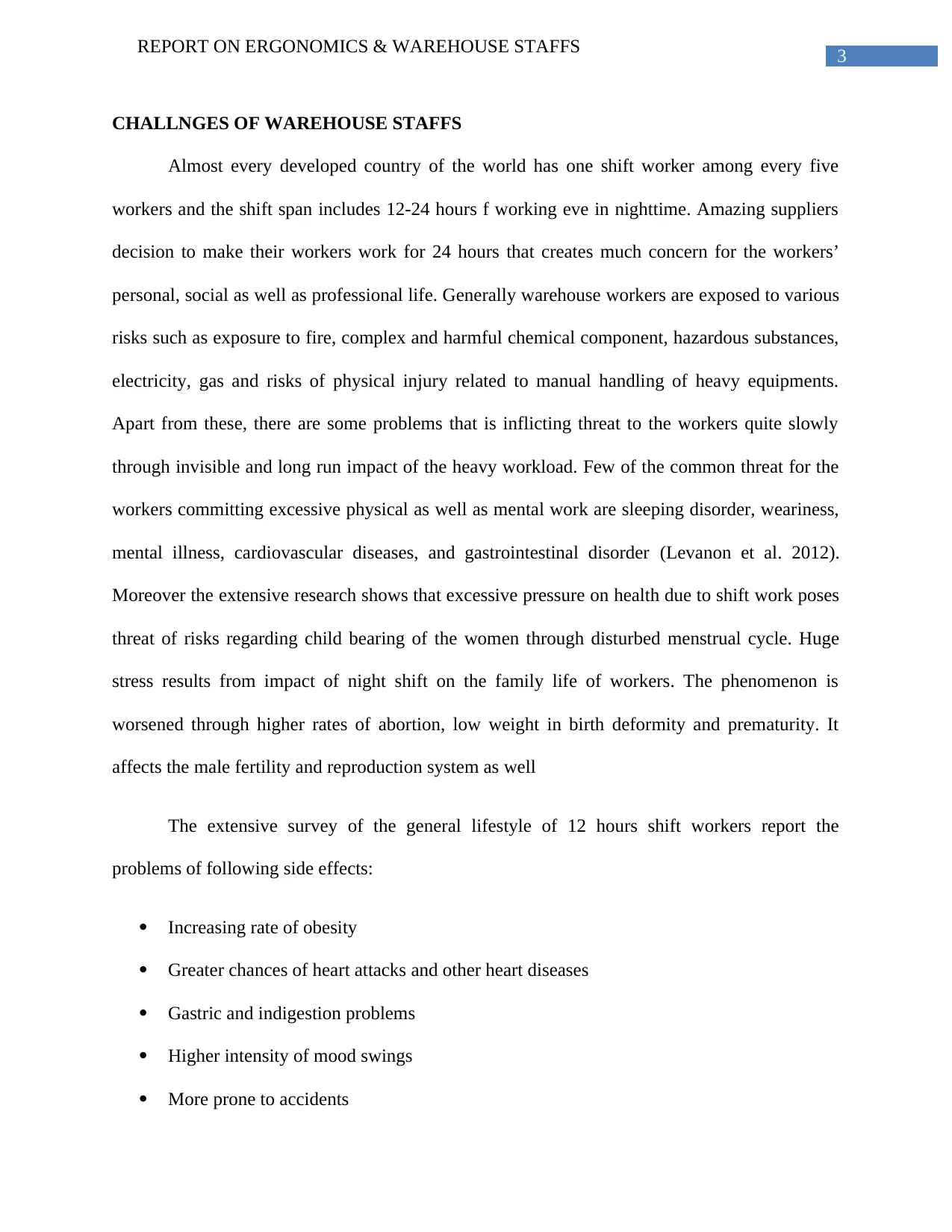
3
REPORT ON ERGONOMICS & WAREHOUSE STAFFS
CHALLNGES OF WAREHOUSE STAFFS
Almost every developed country of the world has one shift worker among every five
workers and the shift span includes 12-24 hours f working eve in nighttime. Amazing suppliers
decision to make their workers work for 24 hours that creates much concern for the workers’
personal, social as well as professional life. Generally warehouse workers are exposed to various
risks such as exposure to fire, complex and harmful chemical component, hazardous substances,
electricity, gas and risks of physical injury related to manual handling of heavy equipments.
Apart from these, there are some problems that is inflicting threat to the workers quite slowly
through invisible and long run impact of the heavy workload. Few of the common threat for the
workers committing excessive physical as well as mental work are sleeping disorder, weariness,
mental illness, cardiovascular diseases, and gastrointestinal disorder (Levanon et al. 2012).
Moreover the extensive research shows that excessive pressure on health due to shift work poses
threat of risks regarding child bearing of the women through disturbed menstrual cycle. Huge
stress results from impact of night shift on the family life of workers. The phenomenon is
worsened through higher rates of abortion, low weight in birth deformity and prematurity. It
affects the male fertility and reproduction system as well
The extensive survey of the general lifestyle of 12 hours shift workers report the
problems of following side effects:
Increasing rate of obesity
Greater chances of heart attacks and other heart diseases
Gastric and indigestion problems
Higher intensity of mood swings
More prone to accidents
REPORT ON ERGONOMICS & WAREHOUSE STAFFS
CHALLNGES OF WAREHOUSE STAFFS
Almost every developed country of the world has one shift worker among every five
workers and the shift span includes 12-24 hours f working eve in nighttime. Amazing suppliers
decision to make their workers work for 24 hours that creates much concern for the workers’
personal, social as well as professional life. Generally warehouse workers are exposed to various
risks such as exposure to fire, complex and harmful chemical component, hazardous substances,
electricity, gas and risks of physical injury related to manual handling of heavy equipments.
Apart from these, there are some problems that is inflicting threat to the workers quite slowly
through invisible and long run impact of the heavy workload. Few of the common threat for the
workers committing excessive physical as well as mental work are sleeping disorder, weariness,
mental illness, cardiovascular diseases, and gastrointestinal disorder (Levanon et al. 2012).
Moreover the extensive research shows that excessive pressure on health due to shift work poses
threat of risks regarding child bearing of the women through disturbed menstrual cycle. Huge
stress results from impact of night shift on the family life of workers. The phenomenon is
worsened through higher rates of abortion, low weight in birth deformity and prematurity. It
affects the male fertility and reproduction system as well
The extensive survey of the general lifestyle of 12 hours shift workers report the
problems of following side effects:
Increasing rate of obesity
Greater chances of heart attacks and other heart diseases
Gastric and indigestion problems
Higher intensity of mood swings
More prone to accidents
Paraphrase This Document
Need a fresh take? Get an instant paraphrase of this document with our AI Paraphraser
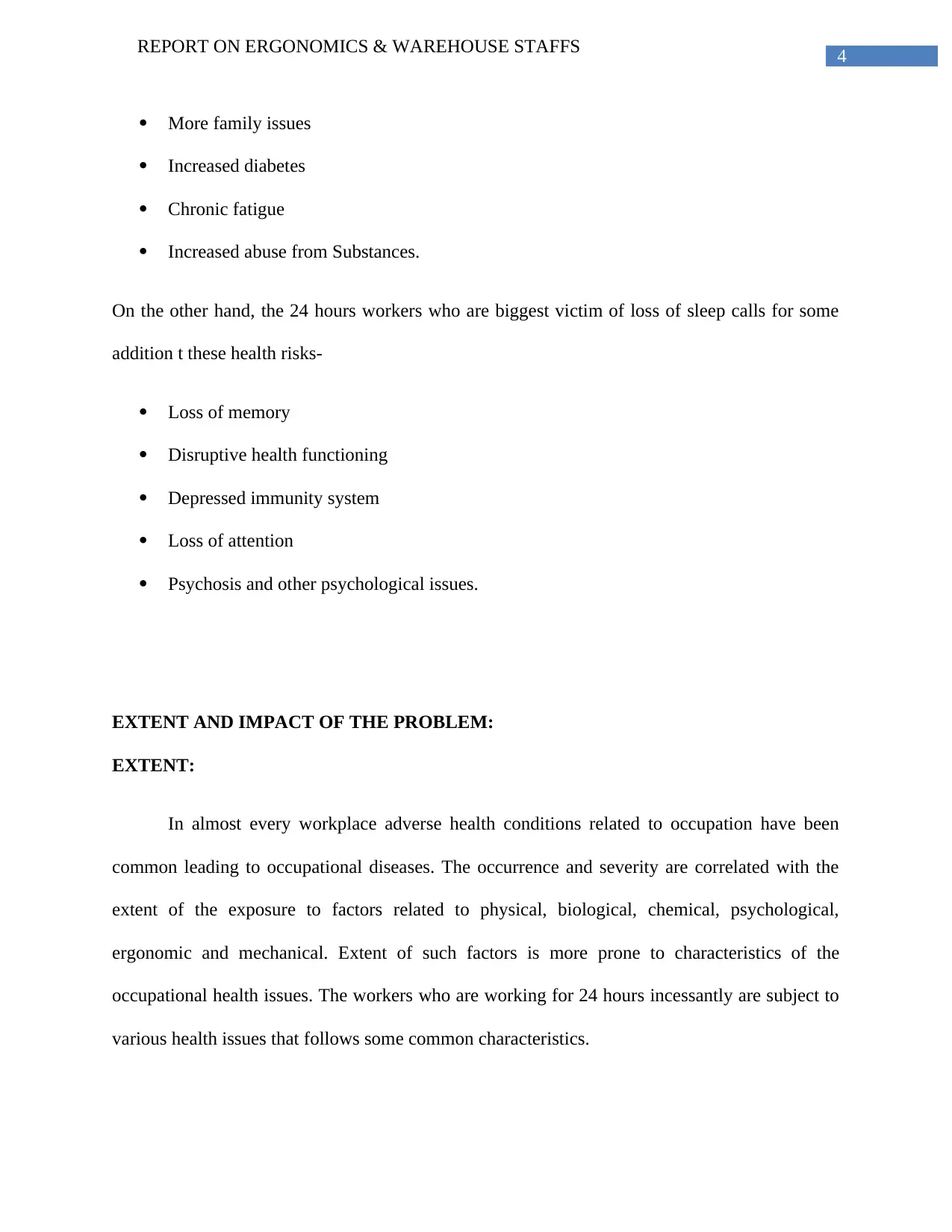
4
REPORT ON ERGONOMICS & WAREHOUSE STAFFS
More family issues
Increased diabetes
Chronic fatigue
Increased abuse from Substances.
On the other hand, the 24 hours workers who are biggest victim of loss of sleep calls for some
addition t these health risks-
Loss of memory
Disruptive health functioning
Depressed immunity system
Loss of attention
Psychosis and other psychological issues.
EXTENT AND IMPACT OF THE PROBLEM:
EXTENT:
In almost every workplace adverse health conditions related to occupation have been
common leading to occupational diseases. The occurrence and severity are correlated with the
extent of the exposure to factors related to physical, biological, chemical, psychological,
ergonomic and mechanical. Extent of such factors is more prone to characteristics of the
occupational health issues. The workers who are working for 24 hours incessantly are subject to
various health issues that follows some common characteristics.
REPORT ON ERGONOMICS & WAREHOUSE STAFFS
More family issues
Increased diabetes
Chronic fatigue
Increased abuse from Substances.
On the other hand, the 24 hours workers who are biggest victim of loss of sleep calls for some
addition t these health risks-
Loss of memory
Disruptive health functioning
Depressed immunity system
Loss of attention
Psychosis and other psychological issues.
EXTENT AND IMPACT OF THE PROBLEM:
EXTENT:
In almost every workplace adverse health conditions related to occupation have been
common leading to occupational diseases. The occurrence and severity are correlated with the
extent of the exposure to factors related to physical, biological, chemical, psychological,
ergonomic and mechanical. Extent of such factors is more prone to characteristics of the
occupational health issues. The workers who are working for 24 hours incessantly are subject to
various health issues that follows some common characteristics.
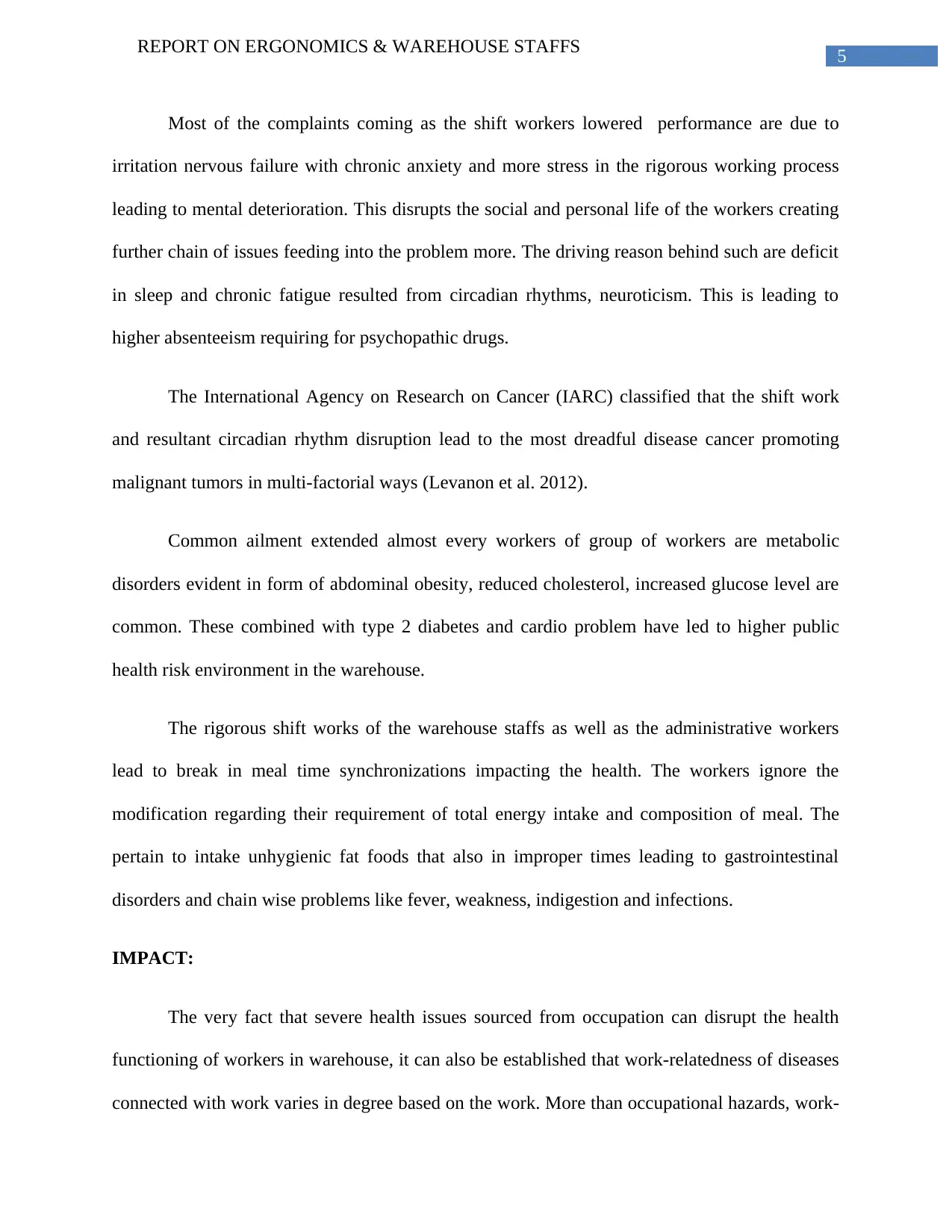
5
REPORT ON ERGONOMICS & WAREHOUSE STAFFS
Most of the complaints coming as the shift workers lowered performance are due to
irritation nervous failure with chronic anxiety and more stress in the rigorous working process
leading to mental deterioration. This disrupts the social and personal life of the workers creating
further chain of issues feeding into the problem more. The driving reason behind such are deficit
in sleep and chronic fatigue resulted from circadian rhythms, neuroticism. This is leading to
higher absenteeism requiring for psychopathic drugs.
The International Agency on Research on Cancer (IARC) classified that the shift work
and resultant circadian rhythm disruption lead to the most dreadful disease cancer promoting
malignant tumors in multi-factorial ways (Levanon et al. 2012).
Common ailment extended almost every workers of group of workers are metabolic
disorders evident in form of abdominal obesity, reduced cholesterol, increased glucose level are
common. These combined with type 2 diabetes and cardio problem have led to higher public
health risk environment in the warehouse.
The rigorous shift works of the warehouse staffs as well as the administrative workers
lead to break in meal time synchronizations impacting the health. The workers ignore the
modification regarding their requirement of total energy intake and composition of meal. The
pertain to intake unhygienic fat foods that also in improper times leading to gastrointestinal
disorders and chain wise problems like fever, weakness, indigestion and infections.
IMPACT:
The very fact that severe health issues sourced from occupation can disrupt the health
functioning of workers in warehouse, it can also be established that work-relatedness of diseases
connected with work varies in degree based on the work. More than occupational hazards, work-
REPORT ON ERGONOMICS & WAREHOUSE STAFFS
Most of the complaints coming as the shift workers lowered performance are due to
irritation nervous failure with chronic anxiety and more stress in the rigorous working process
leading to mental deterioration. This disrupts the social and personal life of the workers creating
further chain of issues feeding into the problem more. The driving reason behind such are deficit
in sleep and chronic fatigue resulted from circadian rhythms, neuroticism. This is leading to
higher absenteeism requiring for psychopathic drugs.
The International Agency on Research on Cancer (IARC) classified that the shift work
and resultant circadian rhythm disruption lead to the most dreadful disease cancer promoting
malignant tumors in multi-factorial ways (Levanon et al. 2012).
Common ailment extended almost every workers of group of workers are metabolic
disorders evident in form of abdominal obesity, reduced cholesterol, increased glucose level are
common. These combined with type 2 diabetes and cardio problem have led to higher public
health risk environment in the warehouse.
The rigorous shift works of the warehouse staffs as well as the administrative workers
lead to break in meal time synchronizations impacting the health. The workers ignore the
modification regarding their requirement of total energy intake and composition of meal. The
pertain to intake unhygienic fat foods that also in improper times leading to gastrointestinal
disorders and chain wise problems like fever, weakness, indigestion and infections.
IMPACT:
The very fact that severe health issues sourced from occupation can disrupt the health
functioning of workers in warehouse, it can also be established that work-relatedness of diseases
connected with work varies in degree based on the work. More than occupational hazards, work-
⊘ This is a preview!⊘
Do you want full access?
Subscribe today to unlock all pages.

Trusted by 1+ million students worldwide
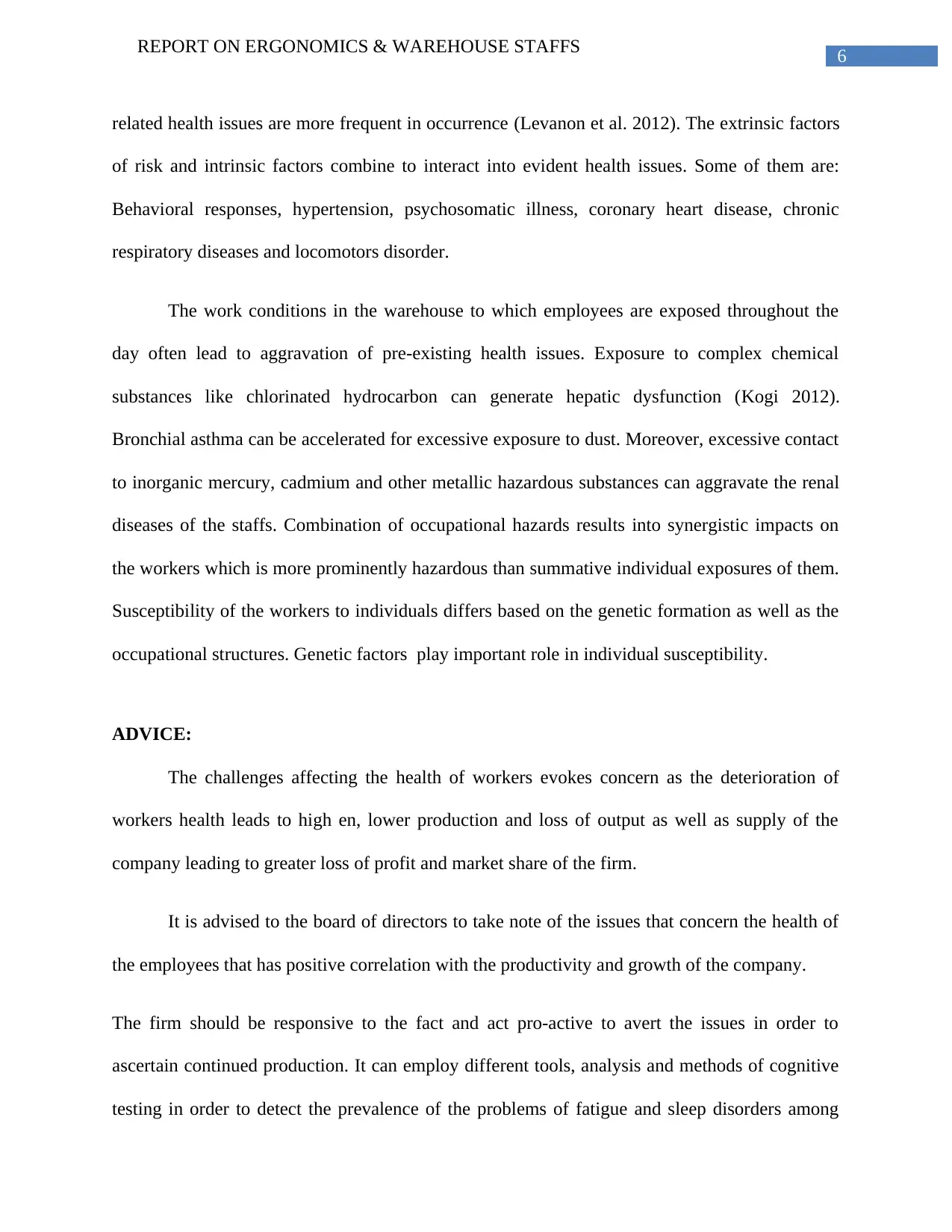
6
REPORT ON ERGONOMICS & WAREHOUSE STAFFS
related health issues are more frequent in occurrence (Levanon et al. 2012). The extrinsic factors
of risk and intrinsic factors combine to interact into evident health issues. Some of them are:
Behavioral responses, hypertension, psychosomatic illness, coronary heart disease, chronic
respiratory diseases and locomotors disorder.
The work conditions in the warehouse to which employees are exposed throughout the
day often lead to aggravation of pre-existing health issues. Exposure to complex chemical
substances like chlorinated hydrocarbon can generate hepatic dysfunction (Kogi 2012).
Bronchial asthma can be accelerated for excessive exposure to dust. Moreover, excessive contact
to inorganic mercury, cadmium and other metallic hazardous substances can aggravate the renal
diseases of the staffs. Combination of occupational hazards results into synergistic impacts on
the workers which is more prominently hazardous than summative individual exposures of them.
Susceptibility of the workers to individuals differs based on the genetic formation as well as the
occupational structures. Genetic factors play important role in individual susceptibility.
ADVICE:
The challenges affecting the health of workers evokes concern as the deterioration of
workers health leads to high en, lower production and loss of output as well as supply of the
company leading to greater loss of profit and market share of the firm.
It is advised to the board of directors to take note of the issues that concern the health of
the employees that has positive correlation with the productivity and growth of the company.
The firm should be responsive to the fact and act pro-active to avert the issues in order to
ascertain continued production. It can employ different tools, analysis and methods of cognitive
testing in order to detect the prevalence of the problems of fatigue and sleep disorders among
REPORT ON ERGONOMICS & WAREHOUSE STAFFS
related health issues are more frequent in occurrence (Levanon et al. 2012). The extrinsic factors
of risk and intrinsic factors combine to interact into evident health issues. Some of them are:
Behavioral responses, hypertension, psychosomatic illness, coronary heart disease, chronic
respiratory diseases and locomotors disorder.
The work conditions in the warehouse to which employees are exposed throughout the
day often lead to aggravation of pre-existing health issues. Exposure to complex chemical
substances like chlorinated hydrocarbon can generate hepatic dysfunction (Kogi 2012).
Bronchial asthma can be accelerated for excessive exposure to dust. Moreover, excessive contact
to inorganic mercury, cadmium and other metallic hazardous substances can aggravate the renal
diseases of the staffs. Combination of occupational hazards results into synergistic impacts on
the workers which is more prominently hazardous than summative individual exposures of them.
Susceptibility of the workers to individuals differs based on the genetic formation as well as the
occupational structures. Genetic factors play important role in individual susceptibility.
ADVICE:
The challenges affecting the health of workers evokes concern as the deterioration of
workers health leads to high en, lower production and loss of output as well as supply of the
company leading to greater loss of profit and market share of the firm.
It is advised to the board of directors to take note of the issues that concern the health of
the employees that has positive correlation with the productivity and growth of the company.
The firm should be responsive to the fact and act pro-active to avert the issues in order to
ascertain continued production. It can employ different tools, analysis and methods of cognitive
testing in order to detect the prevalence of the problems of fatigue and sleep disorders among
Paraphrase This Document
Need a fresh take? Get an instant paraphrase of this document with our AI Paraphraser
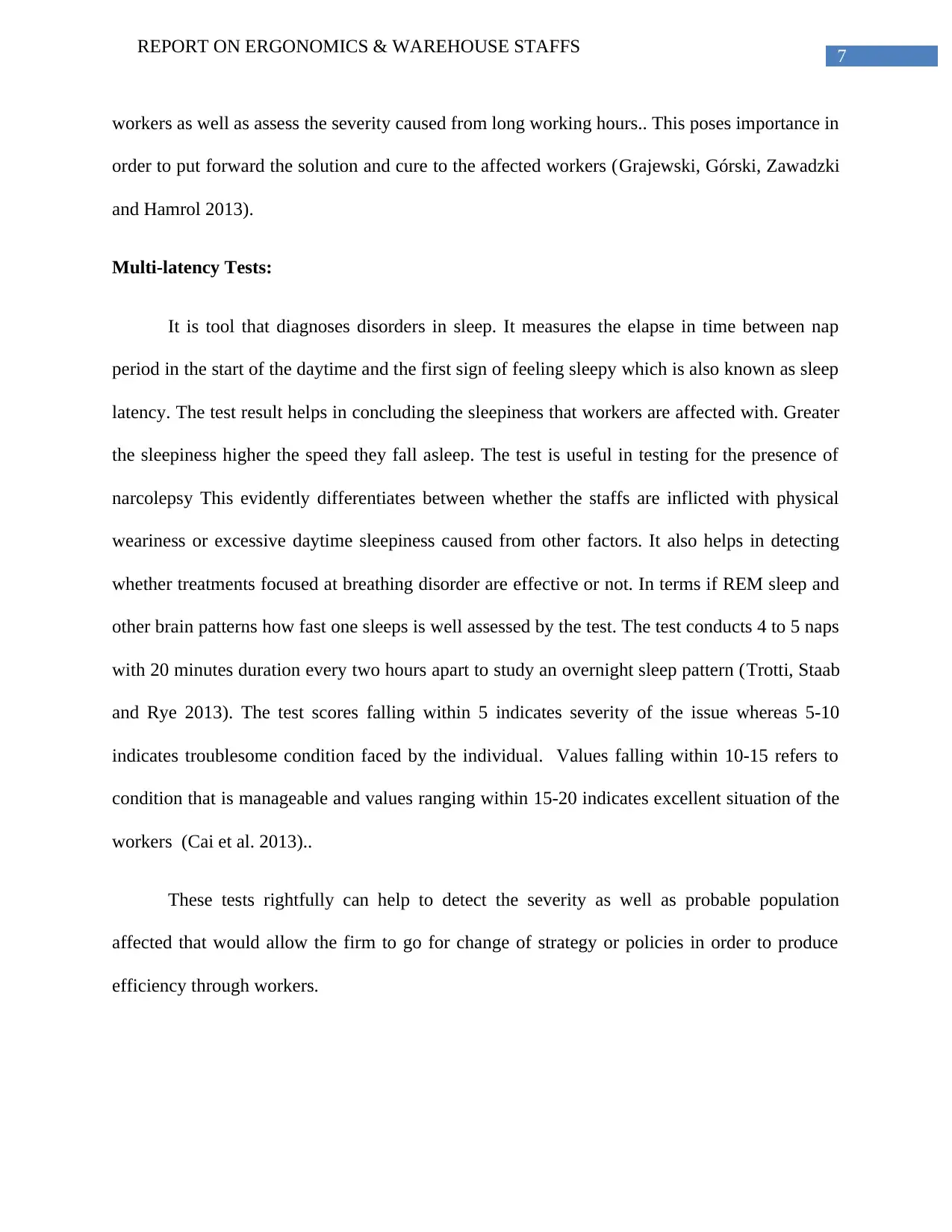
7
REPORT ON ERGONOMICS & WAREHOUSE STAFFS
workers as well as assess the severity caused from long working hours.. This poses importance in
order to put forward the solution and cure to the affected workers (Grajewski, Górski, Zawadzki
and Hamrol 2013).
Multi-latency Tests:
It is tool that diagnoses disorders in sleep. It measures the elapse in time between nap
period in the start of the daytime and the first sign of feeling sleepy which is also known as sleep
latency. The test result helps in concluding the sleepiness that workers are affected with. Greater
the sleepiness higher the speed they fall asleep. The test is useful in testing for the presence of
narcolepsy This evidently differentiates between whether the staffs are inflicted with physical
weariness or excessive daytime sleepiness caused from other factors. It also helps in detecting
whether treatments focused at breathing disorder are effective or not. In terms if REM sleep and
other brain patterns how fast one sleeps is well assessed by the test. The test conducts 4 to 5 naps
with 20 minutes duration every two hours apart to study an overnight sleep pattern (Trotti, Staab
and Rye 2013). The test scores falling within 5 indicates severity of the issue whereas 5-10
indicates troublesome condition faced by the individual. Values falling within 10-15 refers to
condition that is manageable and values ranging within 15-20 indicates excellent situation of the
workers (Cai et al. 2013)..
These tests rightfully can help to detect the severity as well as probable population
affected that would allow the firm to go for change of strategy or policies in order to produce
efficiency through workers.
REPORT ON ERGONOMICS & WAREHOUSE STAFFS
workers as well as assess the severity caused from long working hours.. This poses importance in
order to put forward the solution and cure to the affected workers (Grajewski, Górski, Zawadzki
and Hamrol 2013).
Multi-latency Tests:
It is tool that diagnoses disorders in sleep. It measures the elapse in time between nap
period in the start of the daytime and the first sign of feeling sleepy which is also known as sleep
latency. The test result helps in concluding the sleepiness that workers are affected with. Greater
the sleepiness higher the speed they fall asleep. The test is useful in testing for the presence of
narcolepsy This evidently differentiates between whether the staffs are inflicted with physical
weariness or excessive daytime sleepiness caused from other factors. It also helps in detecting
whether treatments focused at breathing disorder are effective or not. In terms if REM sleep and
other brain patterns how fast one sleeps is well assessed by the test. The test conducts 4 to 5 naps
with 20 minutes duration every two hours apart to study an overnight sleep pattern (Trotti, Staab
and Rye 2013). The test scores falling within 5 indicates severity of the issue whereas 5-10
indicates troublesome condition faced by the individual. Values falling within 10-15 refers to
condition that is manageable and values ranging within 15-20 indicates excellent situation of the
workers (Cai et al. 2013)..
These tests rightfully can help to detect the severity as well as probable population
affected that would allow the firm to go for change of strategy or policies in order to produce
efficiency through workers.
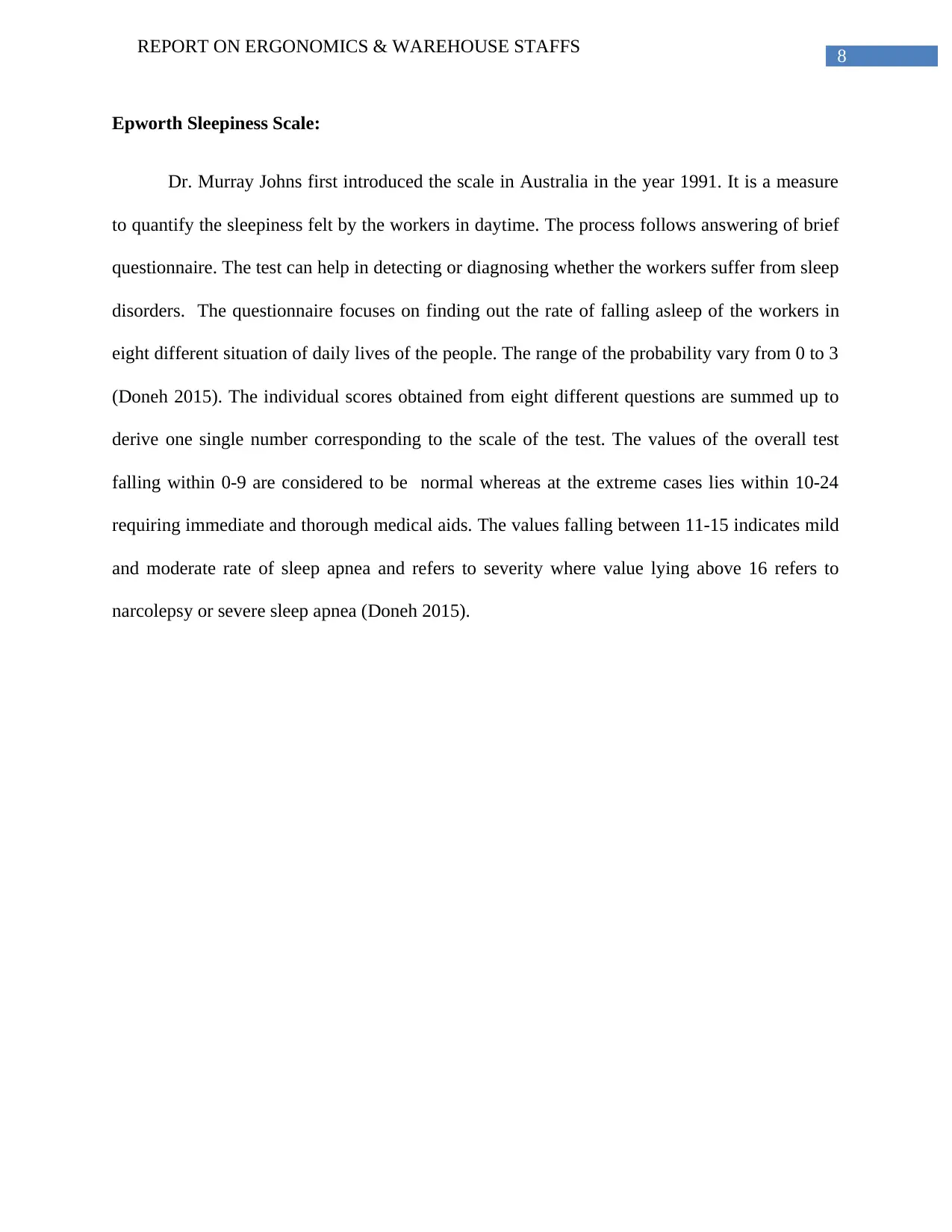
8
REPORT ON ERGONOMICS & WAREHOUSE STAFFS
Epworth Sleepiness Scale:
Dr. Murray Johns first introduced the scale in Australia in the year 1991. It is a measure
to quantify the sleepiness felt by the workers in daytime. The process follows answering of brief
questionnaire. The test can help in detecting or diagnosing whether the workers suffer from sleep
disorders. The questionnaire focuses on finding out the rate of falling asleep of the workers in
eight different situation of daily lives of the people. The range of the probability vary from 0 to 3
(Doneh 2015). The individual scores obtained from eight different questions are summed up to
derive one single number corresponding to the scale of the test. The values of the overall test
falling within 0-9 are considered to be normal whereas at the extreme cases lies within 10-24
requiring immediate and thorough medical aids. The values falling between 11-15 indicates mild
and moderate rate of sleep apnea and refers to severity where value lying above 16 refers to
narcolepsy or severe sleep apnea (Doneh 2015).
REPORT ON ERGONOMICS & WAREHOUSE STAFFS
Epworth Sleepiness Scale:
Dr. Murray Johns first introduced the scale in Australia in the year 1991. It is a measure
to quantify the sleepiness felt by the workers in daytime. The process follows answering of brief
questionnaire. The test can help in detecting or diagnosing whether the workers suffer from sleep
disorders. The questionnaire focuses on finding out the rate of falling asleep of the workers in
eight different situation of daily lives of the people. The range of the probability vary from 0 to 3
(Doneh 2015). The individual scores obtained from eight different questions are summed up to
derive one single number corresponding to the scale of the test. The values of the overall test
falling within 0-9 are considered to be normal whereas at the extreme cases lies within 10-24
requiring immediate and thorough medical aids. The values falling between 11-15 indicates mild
and moderate rate of sleep apnea and refers to severity where value lying above 16 refers to
narcolepsy or severe sleep apnea (Doneh 2015).
⊘ This is a preview!⊘
Do you want full access?
Subscribe today to unlock all pages.

Trusted by 1+ million students worldwide
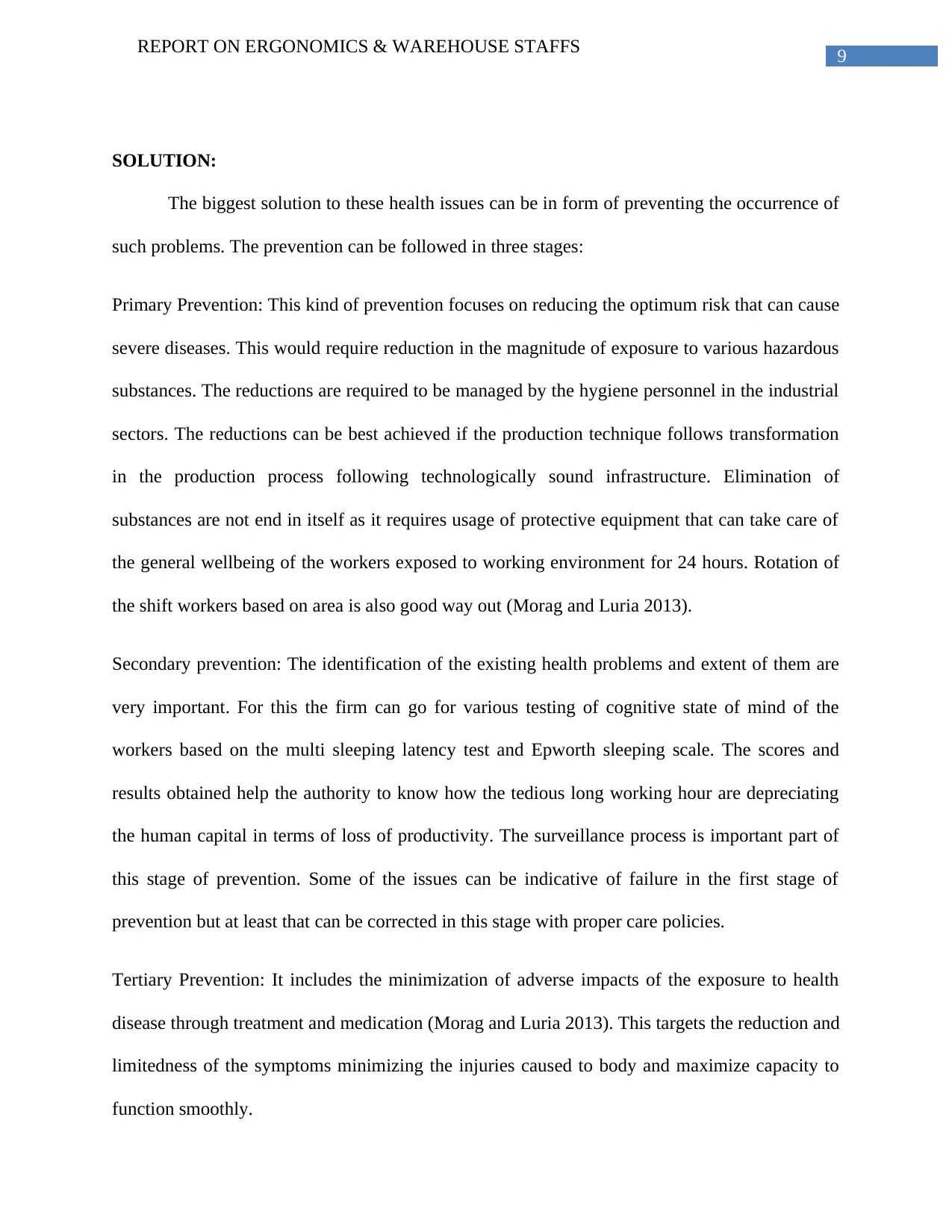
9
REPORT ON ERGONOMICS & WAREHOUSE STAFFS
SOLUTION:
The biggest solution to these health issues can be in form of preventing the occurrence of
such problems. The prevention can be followed in three stages:
Primary Prevention: This kind of prevention focuses on reducing the optimum risk that can cause
severe diseases. This would require reduction in the magnitude of exposure to various hazardous
substances. The reductions are required to be managed by the hygiene personnel in the industrial
sectors. The reductions can be best achieved if the production technique follows transformation
in the production process following technologically sound infrastructure. Elimination of
substances are not end in itself as it requires usage of protective equipment that can take care of
the general wellbeing of the workers exposed to working environment for 24 hours. Rotation of
the shift workers based on area is also good way out (Morag and Luria 2013).
Secondary prevention: The identification of the existing health problems and extent of them are
very important. For this the firm can go for various testing of cognitive state of mind of the
workers based on the multi sleeping latency test and Epworth sleeping scale. The scores and
results obtained help the authority to know how the tedious long working hour are depreciating
the human capital in terms of loss of productivity. The surveillance process is important part of
this stage of prevention. Some of the issues can be indicative of failure in the first stage of
prevention but at least that can be corrected in this stage with proper care policies.
Tertiary Prevention: It includes the minimization of adverse impacts of the exposure to health
disease through treatment and medication (Morag and Luria 2013). This targets the reduction and
limitedness of the symptoms minimizing the injuries caused to body and maximize capacity to
function smoothly.
REPORT ON ERGONOMICS & WAREHOUSE STAFFS
SOLUTION:
The biggest solution to these health issues can be in form of preventing the occurrence of
such problems. The prevention can be followed in three stages:
Primary Prevention: This kind of prevention focuses on reducing the optimum risk that can cause
severe diseases. This would require reduction in the magnitude of exposure to various hazardous
substances. The reductions are required to be managed by the hygiene personnel in the industrial
sectors. The reductions can be best achieved if the production technique follows transformation
in the production process following technologically sound infrastructure. Elimination of
substances are not end in itself as it requires usage of protective equipment that can take care of
the general wellbeing of the workers exposed to working environment for 24 hours. Rotation of
the shift workers based on area is also good way out (Morag and Luria 2013).
Secondary prevention: The identification of the existing health problems and extent of them are
very important. For this the firm can go for various testing of cognitive state of mind of the
workers based on the multi sleeping latency test and Epworth sleeping scale. The scores and
results obtained help the authority to know how the tedious long working hour are depreciating
the human capital in terms of loss of productivity. The surveillance process is important part of
this stage of prevention. Some of the issues can be indicative of failure in the first stage of
prevention but at least that can be corrected in this stage with proper care policies.
Tertiary Prevention: It includes the minimization of adverse impacts of the exposure to health
disease through treatment and medication (Morag and Luria 2013). This targets the reduction and
limitedness of the symptoms minimizing the injuries caused to body and maximize capacity to
function smoothly.
Paraphrase This Document
Need a fresh take? Get an instant paraphrase of this document with our AI Paraphraser
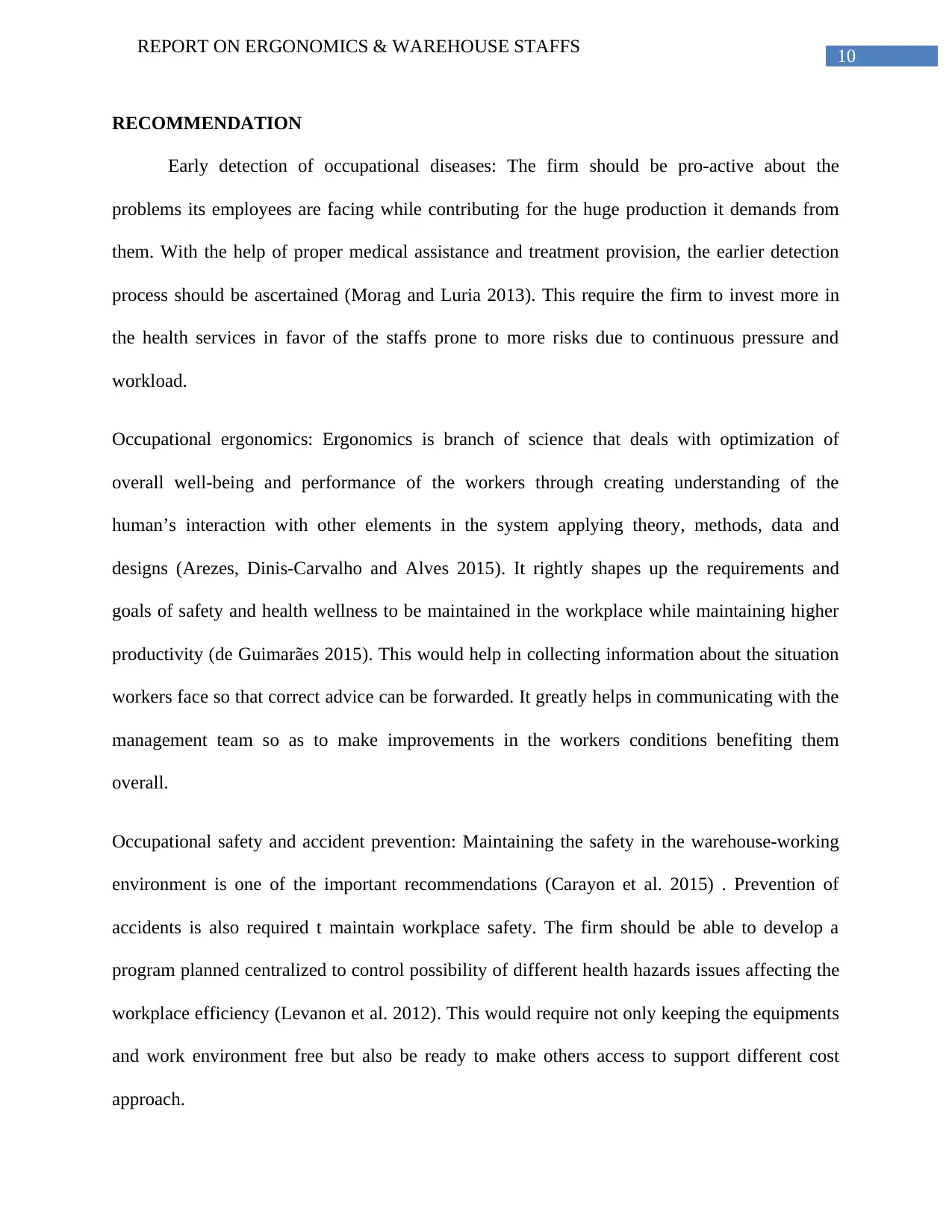
10
REPORT ON ERGONOMICS & WAREHOUSE STAFFS
RECOMMENDATION
Early detection of occupational diseases: The firm should be pro-active about the
problems its employees are facing while contributing for the huge production it demands from
them. With the help of proper medical assistance and treatment provision, the earlier detection
process should be ascertained (Morag and Luria 2013). This require the firm to invest more in
the health services in favor of the staffs prone to more risks due to continuous pressure and
workload.
Occupational ergonomics: Ergonomics is branch of science that deals with optimization of
overall well-being and performance of the workers through creating understanding of the
human’s interaction with other elements in the system applying theory, methods, data and
designs (Arezes, Dinis-Carvalho and Alves 2015). It rightly shapes up the requirements and
goals of safety and health wellness to be maintained in the workplace while maintaining higher
productivity (de Guimarães 2015). This would help in collecting information about the situation
workers face so that correct advice can be forwarded. It greatly helps in communicating with the
management team so as to make improvements in the workers conditions benefiting them
overall.
Occupational safety and accident prevention: Maintaining the safety in the warehouse-working
environment is one of the important recommendations (Carayon et al. 2015) . Prevention of
accidents is also required t maintain workplace safety. The firm should be able to develop a
program planned centralized to control possibility of different health hazards issues affecting the
workplace efficiency (Levanon et al. 2012). This would require not only keeping the equipments
and work environment free but also be ready to make others access to support different cost
approach.
REPORT ON ERGONOMICS & WAREHOUSE STAFFS
RECOMMENDATION
Early detection of occupational diseases: The firm should be pro-active about the
problems its employees are facing while contributing for the huge production it demands from
them. With the help of proper medical assistance and treatment provision, the earlier detection
process should be ascertained (Morag and Luria 2013). This require the firm to invest more in
the health services in favor of the staffs prone to more risks due to continuous pressure and
workload.
Occupational ergonomics: Ergonomics is branch of science that deals with optimization of
overall well-being and performance of the workers through creating understanding of the
human’s interaction with other elements in the system applying theory, methods, data and
designs (Arezes, Dinis-Carvalho and Alves 2015). It rightly shapes up the requirements and
goals of safety and health wellness to be maintained in the workplace while maintaining higher
productivity (de Guimarães 2015). This would help in collecting information about the situation
workers face so that correct advice can be forwarded. It greatly helps in communicating with the
management team so as to make improvements in the workers conditions benefiting them
overall.
Occupational safety and accident prevention: Maintaining the safety in the warehouse-working
environment is one of the important recommendations (Carayon et al. 2015) . Prevention of
accidents is also required t maintain workplace safety. The firm should be able to develop a
program planned centralized to control possibility of different health hazards issues affecting the
workplace efficiency (Levanon et al. 2012). This would require not only keeping the equipments
and work environment free but also be ready to make others access to support different cost
approach.
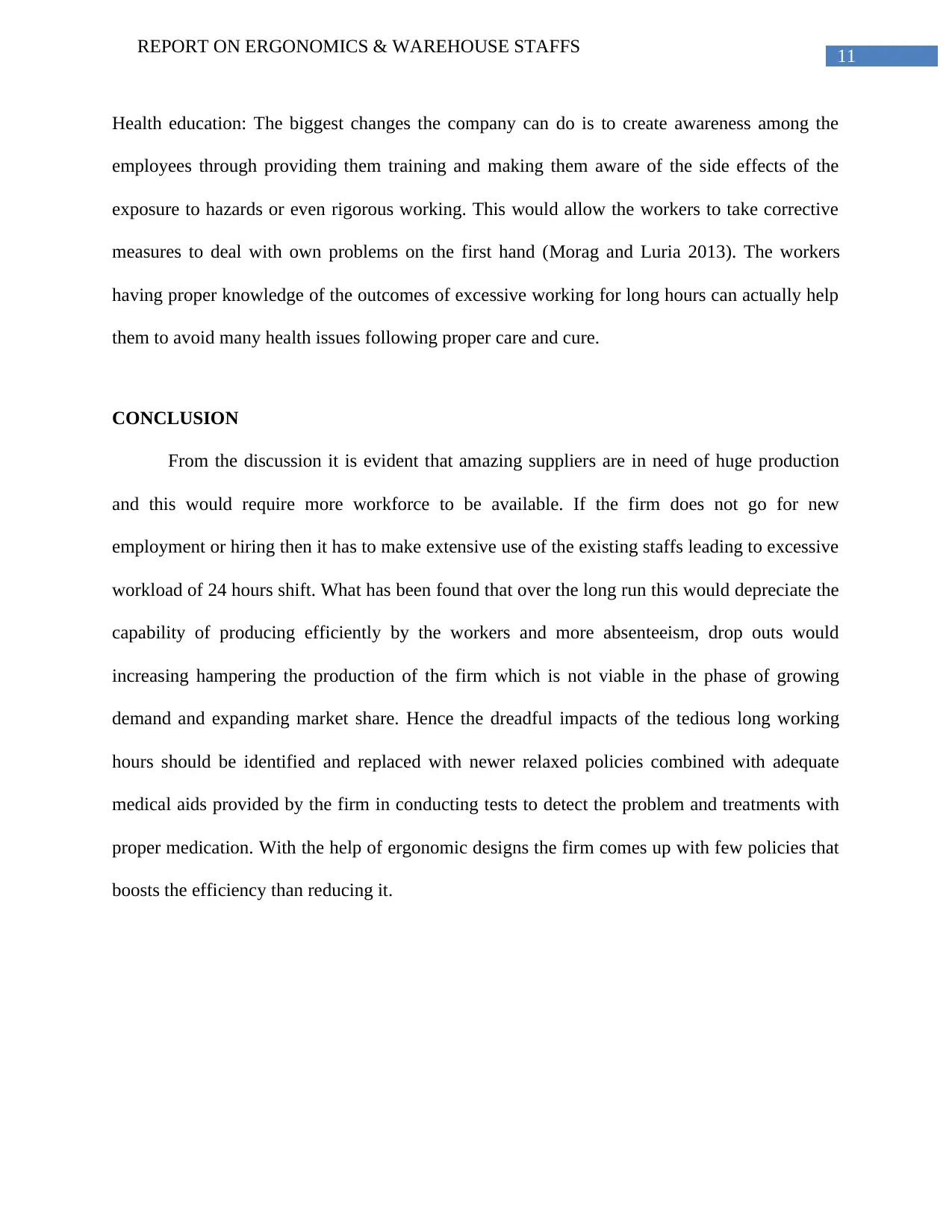
11
REPORT ON ERGONOMICS & WAREHOUSE STAFFS
Health education: The biggest changes the company can do is to create awareness among the
employees through providing them training and making them aware of the side effects of the
exposure to hazards or even rigorous working. This would allow the workers to take corrective
measures to deal with own problems on the first hand (Morag and Luria 2013). The workers
having proper knowledge of the outcomes of excessive working for long hours can actually help
them to avoid many health issues following proper care and cure.
CONCLUSION
From the discussion it is evident that amazing suppliers are in need of huge production
and this would require more workforce to be available. If the firm does not go for new
employment or hiring then it has to make extensive use of the existing staffs leading to excessive
workload of 24 hours shift. What has been found that over the long run this would depreciate the
capability of producing efficiently by the workers and more absenteeism, drop outs would
increasing hampering the production of the firm which is not viable in the phase of growing
demand and expanding market share. Hence the dreadful impacts of the tedious long working
hours should be identified and replaced with newer relaxed policies combined with adequate
medical aids provided by the firm in conducting tests to detect the problem and treatments with
proper medication. With the help of ergonomic designs the firm comes up with few policies that
boosts the efficiency than reducing it.
REPORT ON ERGONOMICS & WAREHOUSE STAFFS
Health education: The biggest changes the company can do is to create awareness among the
employees through providing them training and making them aware of the side effects of the
exposure to hazards or even rigorous working. This would allow the workers to take corrective
measures to deal with own problems on the first hand (Morag and Luria 2013). The workers
having proper knowledge of the outcomes of excessive working for long hours can actually help
them to avoid many health issues following proper care and cure.
CONCLUSION
From the discussion it is evident that amazing suppliers are in need of huge production
and this would require more workforce to be available. If the firm does not go for new
employment or hiring then it has to make extensive use of the existing staffs leading to excessive
workload of 24 hours shift. What has been found that over the long run this would depreciate the
capability of producing efficiently by the workers and more absenteeism, drop outs would
increasing hampering the production of the firm which is not viable in the phase of growing
demand and expanding market share. Hence the dreadful impacts of the tedious long working
hours should be identified and replaced with newer relaxed policies combined with adequate
medical aids provided by the firm in conducting tests to detect the problem and treatments with
proper medication. With the help of ergonomic designs the firm comes up with few policies that
boosts the efficiency than reducing it.
⊘ This is a preview!⊘
Do you want full access?
Subscribe today to unlock all pages.

Trusted by 1+ million students worldwide
1 out of 15
Your All-in-One AI-Powered Toolkit for Academic Success.
+13062052269
info@desklib.com
Available 24*7 on WhatsApp / Email
![[object Object]](/_next/static/media/star-bottom.7253800d.svg)
Unlock your academic potential
Copyright © 2020–2025 A2Z Services. All Rights Reserved. Developed and managed by ZUCOL.


